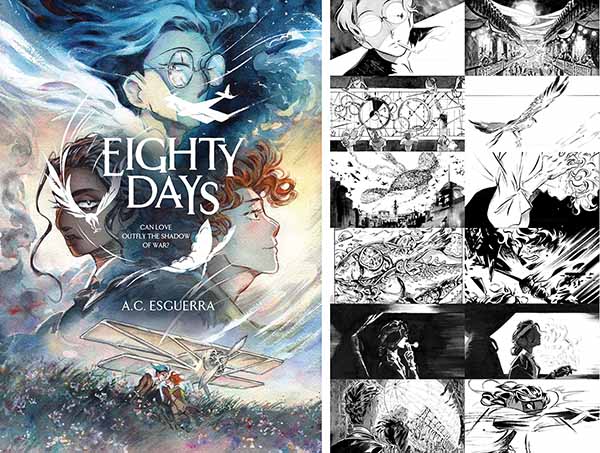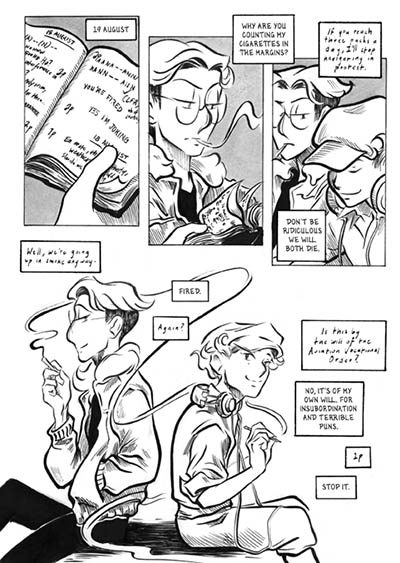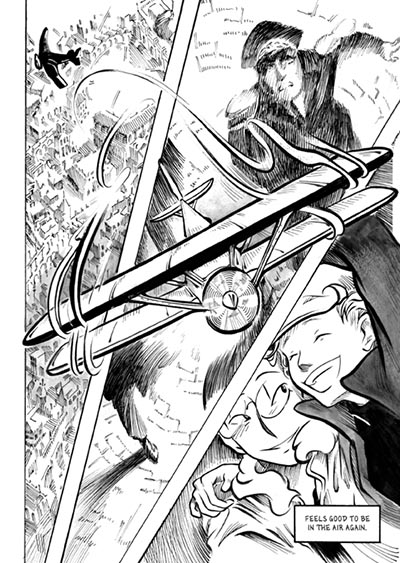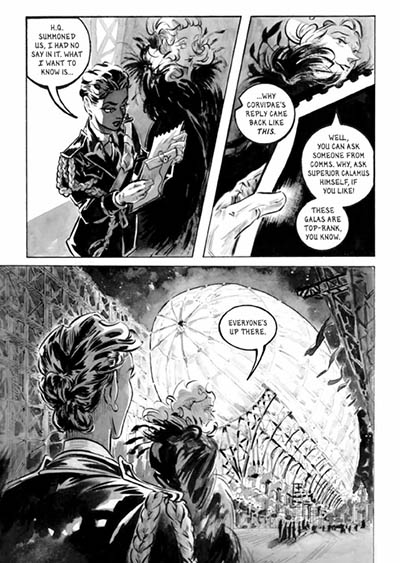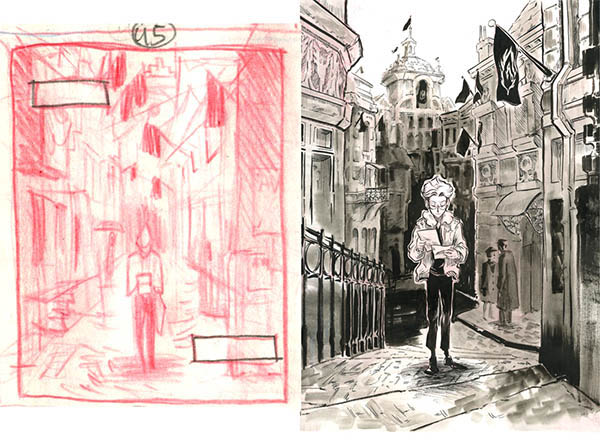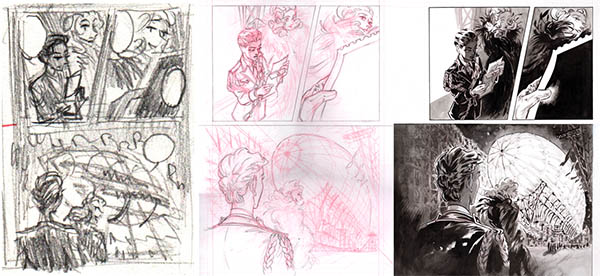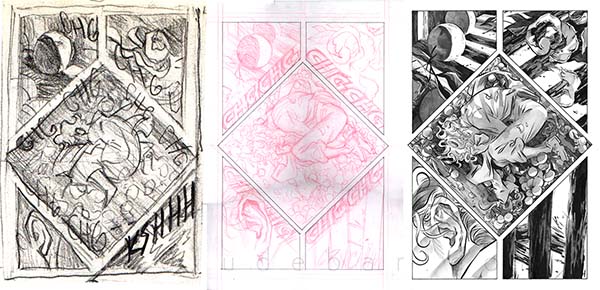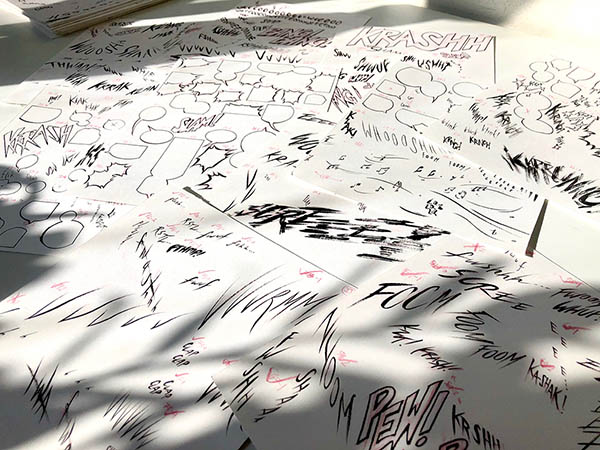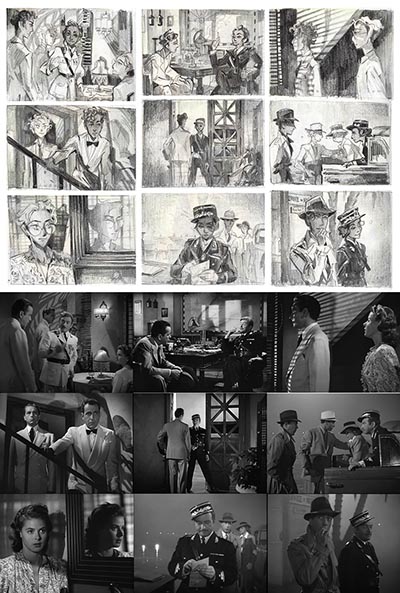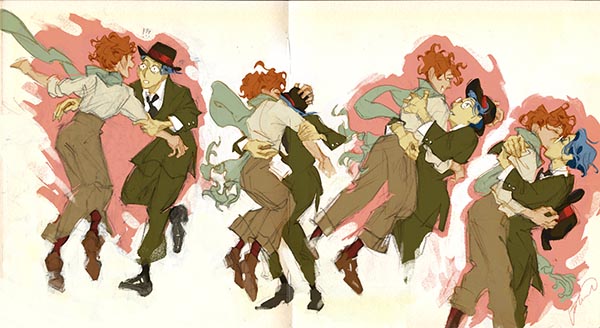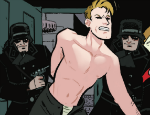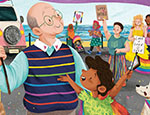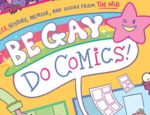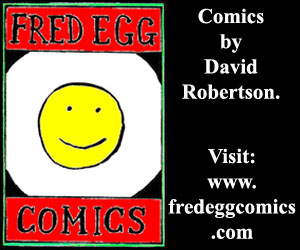PRIDE MONTH 2024! Our Inside Look feature at Broken Frontier provides creators with the opportunity to share exclusive commentaries on their comics projects with our readers, giving insights into the genesis, process and themes of their work. It’s one of the oldest regular features at BF, first appearing on the site back in the mid-2000s and also one of our most well-received. Today, as part of our Pride Month 2024 celebrations (and as a special treat as our Pride coverage enters its final days) A.C. Esguerra gives us an exclusive creator’s commentary on their graphic novel Eighty Days.
The cover and selected panels from Eighty Days
Eighty Days is an award-winning adventure about pilots, queer romance and rebellion in an alternate-historical 1930s world. Jay is a talented but aloof pilot who’s content flying routine jobs for AVO, the ruling air power—until, that is, he meets and falls for Fix, a charming radio whiz with mysterious connections. At the same time, Jay’s old friend and fellow aviator, Sable finds herself rising through AVO’s ranks. Through their journal entries, secret telegrams and notes, the entangled fate of all three characters unfolds into a sweeping tale about flight, freedom and enduring love.
Comic pages from Eighty Days
After coming up with concept, character designs and style direction, my comics process always starts with writing a script. I mark up a printout with a red pencil, sectioning off the text by how much plot I think will fit into each page. Based on that, I draw tiny thumbnails. I love this stage best because it’s when the comic starts to feel alive! I get a better sense of how the story will flow and ideas on how to improve pacing. If needed, I’ll redraw thumbs a few times. That way, most of the major storytelling decisions have been made when I move on to drawing the pages at full size.
Final pages are drawn with traditional ink, sable brush and nib pen on 36 x 44 cm (14×17 inch) bristol paper. Working in trad media helps me feel connected to the art in the moment, as well as to the long history of comic artists and illustrators who came before and inspire me. For this story, the texture and washes of traditional ink also happen to suit the historical, film noir-inspired aesthetic.
An example of what the comic pages look like at thumbnail, pencil and ink stages
To letter the comic, I used fountain pen and an Ames guide to make samples of my own handwriting. Then I chose the best letterforms to make a digital font. Most of the comic uses this, except for certain parts where characters write letters to each other. I wrote their notes by hand, shifting writing styles to show different characters’ personalities. Even the word balloons and narration boxes were drawn with fountain pen, which was a huge pain! Luckily, I was able to reuse a lot of them across the book. But the most fun I had lettering? The sound effects—by far.
Sound effects were painted separately from the art, then placed digitally
The cover is a special example, being the only part of the book in full color. To paint it, I used traditional watercolor on Arches paper. There’s a full video on my Patreon.
When I first came up with the idea that became Eighty Days, I was working two part-time jobs as a museum security guard and a theater usher. On my breaks I was reading the autobiographies of real-life 1930s pilots Beryl Markham and Antoine de-Saint Exupery. I loved how they wrote about the romance and beauty of aviation’s early days, but also its danger, difficulty, bureaucracy and isolation. Other major inspirations are Studio Ghibli’s Porco Rosso, the works of Naoki Urasawa and the Wachowskis’ Cloud Atlas. But most of my research for the comic had to do with the Golden Age of aviation and black-and-white Old Hollywood movies.
For me—a queer, nonbinary Asian American immigrant—it can be complicated to be a fan of that history, those stories. Much of it relegates people like myself to the sidelines at best, and to much worse, more often. Adventure and imperialism often go hand in hand. I wanted to create queer, POC characters who would confront that truth. But in Eighty Days, they also find ways to struggle, live and love despite it. This comic was a way to make the stories that I love, love me back.
Studies of shots from Casablanca (1947), redrawn with characters from Eighty Days
That said, I wasn’t sure mainstream publishing would touch it back in 2014. I drew the first 80 pages for my senior thesis in art school. After graduating, I tabled at indie comic and anime conventions to pay the rent. That’s where I self-published and sold the first part of the story in a small run—there’s maybe 100 copies floating around. My partner perfect-bound all of them by hand. It’s all kind of nuts, looking back. But when that “novella” version of the comic won a PRISM Comics Queer Press Grant, I felt encouraged to keep developing it. A few years later, I signed with my literary agent and Archaia made an offer for the complete book.
Eighty Days first hit the shelves in 2021 and went on to receive a nomination for the GLAAD Media Awards and a place on YALSA’s Great Graphic Novels for Teens List. I’m so grateful that new readers continue to find it year after year. You can find it wherever books are sold, but by all means, support your local comics shop, indie bookstore or public library if you can. For the latest updates on what I’m drawing next, follow me at patreon.com/blueludebar or on instagram @blueludebar. Thanks for reading!
Fix leaps into Jay’s arms for a kiss. Happy Pride month!
Article by A.C. Esguerra





